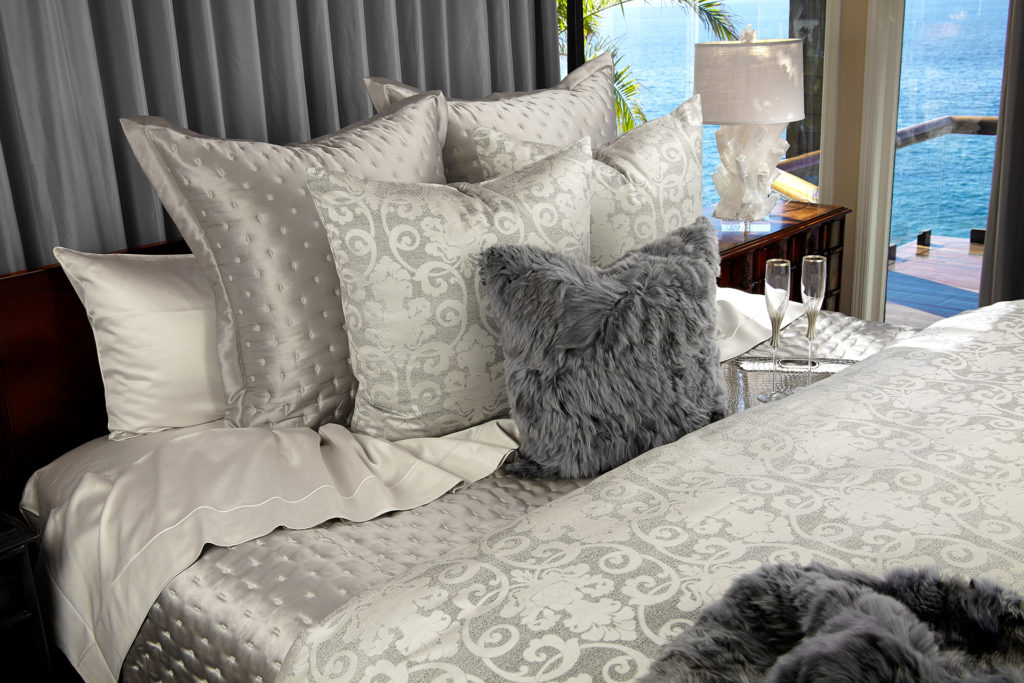Our Quality Manufacturing Process
All of our spinning is done in Switzerland, Italy, and Germany because they celebrate the tradition of manufacturing the finest bed linen. Fiber can be spun into varying degrees of thickness, known as the gauge. We demand the finest and thinnest fiber possible, which can only be accomplished when you start out with the strongest grade of cotton to begin with. Most sheets are woven from 60- or 80-gauge yarn, which is relatively coarse. We weave a much finer 120-gauge yarn, even 140-gauge in some cases. If yarn were pasta, 80-gauge yarn would be spaghetti and 120-gauge yarn would be angel hair.

Our yarn is also plied or twisted, an expensive process by which several very fine fibers are incorporated into the final yarn, making the fabric much stronger and durable. It also helps to eliminate “pilling,” the annoying appearance of little pieces of fuzz caused by the simple friction of your body on fitted or bottom sheets of ordinary quality.
There are different kinds of weaves, and most high-thread-count fabrics, including 600-plied yarns and 1,000-plied yarns sheets, are a sateen weave. Most high-plied yarns sateen-weave sheets are woven three-and-one (three over and one under). We weave seven-and-one, which gives a silk-like feel to the fabric, a quality Between The Sheets is particularly famous for.
High thread numbers alone do not make a fine sheet. If corners were cut anywhere along the way, the end result will still be ordinary. We do not set out to make an expensive sheet, nor do we set out to make a sheet for a certain price, we simply set out to make the best sheets you’ve ever felt.
The fabric then goes through a second process, called mercerizing. Very few manufacturers take the extra step of mercerizing, which removes loose hairs and fuzz and prepares the fabric to take color better during the dye process. Mercerizing is a key step to enhancing the luster of the final product and achieving colors that are full, rich and beautiful.
After mercerizing, the fabric is dyed. At Between The Sheets, we use dyes that deeply penetrate the cotton, in a process called fiber-reactive dyeing. As a result, our colors are deeper and longer lasting, and our sheets are softer. Our blacks are as soft and silky as our whites because we put the color inside the fiber instead of on top of it.
A Cut Above The Rest
As part of our final finishing, we use a process called calendaring which works the fabric to enhance its softness and lustrous finish. Most manufacturers do not take this extra step. Our sheets are then framed and heat set to minimize shrinkage, and finally cut and sewn by experts.
Our sheets are cut 118 inches wide by 120 inches long by 20 to 22 inches deep, where ordinary sheets are 106 inches wide by 108 inches long by 8 to 11 inches deep. Such large pieces of fabric can only be produced on special extra-wide looms, but the resulting generous size sheets make a big difference in the way our sheets fit your bed and in your sleeping comfort. For instance, Between the Sheets’ pillowcases are not just open pillow bags but are completely finished with generous flanged shams on four sides.
All Between The Sheets sewing is done in Europe by artisan sewers who only truly live and breathe the craft of fine sewing. Tight, small, straight stitches, custom sewn to the proper number of stitches per inch is the standard at Between The Sheets.


